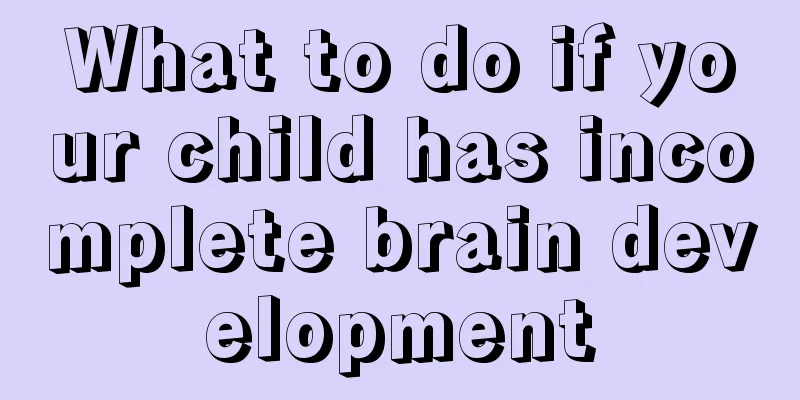What to do if your child has incomplete brain development

|
Every parent hopes that their baby can be smart and healthy, but many parents have often encountered symptoms such as incomplete brain development in infants. This is also the most overwhelming thing for parents. If timely treatment and help for the baby to adjust are not given, it will have a great impact on the child’s doctor, and it will also cause the child to have certain psychological pressure during the growth process. However, if adjustments can be made in time, great improvements can be achieved. Let’s learn about what to do if the infant has incomplete brain development. What to do if your child has incomplete brain development 1. Early diagnosis and early treatment Because the brains of children with cerebral dysplasia are damaged to varying degrees before they mature, certain functions of the central nervous system are impaired. Early treatment can promote effective functional compensation of the damaged brain as it continues to mature and differentiate. In the early stage of the disease, the central nervous system is immature. As the child grows older, the nervous system continues to mature and differentiate, develop new functions, and gradually specialize in various functions. Generally speaking, by the age of 6, the various functions of the central nervous system of a normal child have been basically developed and specialized. Therefore, it may be more difficult to start training various functions after the age of 6. For older children with cerebral dysplasia who have not received early rehabilitation treatment, long-term abnormal postures and reflexes have caused them to develop stubborn, difficult-to-correct abnormal movement patterns. Especially for children with severe spasticity, abnormal posture and movement patterns often further aggravate their spasticity, leading to irreversible tendon contracture and bone and joint deformities, which makes rehabilitation treatment extremely difficult. 2. Comprehensive treatment, long-term persistence Regardless of the type of dysfunction, it is difficult to achieve the desired effect using only a single treatment measure. The same applies to the motor dysfunction of children with cerebral dysplasia. It is necessary to choose appropriate exercise therapy and conduct repeated training, and to cooperate with other measures such as physical therapy, acupuncture, massage, acupressure, psychotherapy and other comprehensive treatments. Only in this way can the intended purpose be achieved. In addition, when parents and rehabilitation personnel conduct training, they should proceed step by step and not rush, and they should persevere and not give up halfway. 3. Emphasize parental involvement in treatment Rehabilitation treatment for cerebral dysplasia requires a long process. Many training movements must be completed in a one-on-one situation, that is, one therapist trains one child, and some even require a two-on-one situation to complete. Moreover, it is impossible to solve all the problems of children by relying solely on 1 to 2 hours of training per day by therapists in rehabilitation institutions. Therefore, training should be integrated into daily family life to ensure that children can receive long-term, systematic and reasonable training at home. To achieve this goal, parental involvement in treatment must be emphasized. The family is a familiar environment for children, and parents are their best teachers. Training for children can easily eliminate their psychological barriers, enable children to actively cooperate, and achieve good training results. Therefore, parents must master basic training methods and principles, understand the long-term and arduous nature of disease treatment, and understand the advantages and significance of family rehabilitation. Close cooperation between parents and therapists is extremely important for the rehabilitation treatment of children with cerebral dysplasia. 4. Cater to the psychology of children and stimulate their initiative When formulating training plans, therapists and parents should pay attention to catering to the psychology of the children, and give timely and appropriate encouragement to the efforts and progress made by the children during the training process to enhance the children's confidence and strengthen these progress. The training items should be arranged from easy to difficult, step by step. Do not let the children feel timid and fearful at the beginning of training, so as to lose the confidence to continue working hard. We should also pay attention to avoiding monotony and boredom in training, and incorporate training into games and entertainment. 5. Rehabilitation training plans should be tailored to individual needs Because each child with cerebral dysplasia has different motor disorders and potential abilities, therapists and parents must develop training plans that are tailored to the individual and not one-size-fits-all. When the child cannot complete the training program well as planned, the reasons should be checked in time and a new training plan suitable for the child should be formulated. Note that all training programs must focus on developing the child's practical functions and lay a solid foundation for his future participation in social life. The above is an introduction to what to do if a child has incomplete brain development. After understanding it, we know that we must observe the baby more often. Once any abnormality is found, we must consult a doctor in time. In addition, if a child has incomplete brain development, we must take more careful care of the child and pay more attention to adjusting the diet. Let the baby eat a light diet and also pay attention to balanced nutrition. |
<<: What is the latest treatment for cerebral palsy in children?
>>: Symptoms of muscular dystrophy in children
Recommend
Baby walks unsteadily and legs are weak
Learning to walk is an indispensable stage in a b...
What vaccines do babies need?
I believe many people know that a baby’s body is ...
What can't children eat when they have acute rash?
We all know that if a child has roseola, what we ...
What are some tips for baby's stuffy nose?
Now with the arrival of spring and summer, the we...
What to do if your baby keeps catching a cold
Whether it is an adult or a child, it is very eas...
What is the cause of the baby's bubble poop?
When children are young, all aspects of their gas...
What should six-year-old children pay attention to in their diet when their vision is declining?
As our living standards continue to improve, ther...
Is my baby's fever serious?
For many new mothers, the biggest worry is that t...
The dangers of weaning at three months
For newborn babies, breast milk is the best food....
What are the reasons why children shake their heads and blink?
The healthy growth of children is very important....
How can children increase their body resistance?
Everyone knows that when the human body's res...
Premature babies cannot lift their heads at three months old
If a premature baby still cannot lift his head af...
Are there any side effects of azithromycin in children?
Azithromycin for children is a nationally approve...
What should I do if my child suffers from memory loss?
We may all have this feeling that some of the thi...
Why does my child keep rubbing his eyes?
It is normal for children to rub their eyes, espe...









